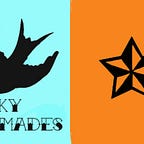MMT2 workbook
For this assignment I collected a variety of materials to join and to join with, to wrap and to wrap with. I mainly dug in to my extensive collection of craft materials, finally making use of some materials that have been in my cupboards for far too long!
Some materials were frustratingly difficult to work with, the balsa wood splits when sewn into with the sewing machine for example. Others were a delight, the swatches I cut out of the plastic folder were opaque enough to show some colour and let other colours through, creating new colours in the process of being layered. They were happy to be stapled or stitched and held their shape uncomplainingly even whilst dangled from trees in the pursuit of an arty photograph. And I finally found a use for a huge stash of colourful business cards with my old email address on!
All in all I had a lot of fun during this assignment and I hope it shows. As always I could have done with many more weeks — but would not have actually achieved more as I need a deadline breathing down my neck to really get the creative juices flowing.
Joining straight flush edges
I sampled many different materials and techniques to find some worked very well, and others didn’t produce good results at all, or broke in the process. Paper, somewhat predictably, could be stitched into, stapled, taped; likewise fabric and thin plastic. The balsa wood tore when stitched into, even when stitched by hand, and could only be used with tape and glue without its structure getting damaged. With paper and plastic, the holes made when stitching or stapling into changed its surface structure and texture somewhat, but I actually liked it when the holes were slightly bigger than the joining material and in some cases this was the most exciting thing about the join.
Overlapping edges
Overlapping the edges and then joining them added a layer of fun. Certain joining methods became possible, such as using a running stitch, others lost their excitement, stapling mostly just became a sensible joining method again (apart from in see through materials like the plastic and lace). By using a Lightbox to take photos of my experiment on you can see the different colours and tones and interesting things that happen when you layer materials on top of each other. I also added safety pins as a joining method, a very “loud” method, one that takes centre stage, not one you can hide in the background. I liked the way it shouted out to be looked at and admired!
Forming corners and angles
In the same way that overlapping edges were exciting, corners and angles were exciting too, but even more so. I really got into the flow properly here, using the joining methods more creatively, adding staples for decoration rather than just for joining purposes, for example. I liked taking the joining method and letting that speak more loudly than the original materials. It appears I have only just plastic in this exercise but they juts happened to be the most exciting samples, I did use other materials too.
Further explorations
I printed with some of my samples, made some exploratory samples in 3D rather than 2D, I created some repeat prints, I combined joining methods, and I explored scale.
Straight wrapping with threads
For this exercise I used a wooden spoon which I wrapped first with a single thread, some garden twine, and then with multiple threads in different thicknesses from very thin gold thread to t-shirt yarn. I like how on the first wrapping the striped thread makes exciting new patterns when the threads are wrapped in different directions. In the second photo I display a wrapping with lumps and bump created by varying the wrapping and changing directions repeatedly. I like how the original object is completely transformed, I think the possibilities for experimentation are endless!
Wrapping with materials and threads
I used a variety of wrapping materials, but did not really find my flow in this exercise. I tried to veer away from a neat present like wrap but didn’t find any of my experiments very succesful. I suspect if I could wrap on an unexpected scale like Christo I would have definitely found my mojo but alas I neither have the funds nor the access to wrap entire buildings or even a small tree!
Uneven wrapping
I absolutely loved this experiment. I didn’t set out with a plan, I just kept adding threads and items and changing directions. At the ends of the objects it often becomes near impossible to completely cover the item as the threads kept slipping off but the loops formed by this were quite inspiring in themselves.
